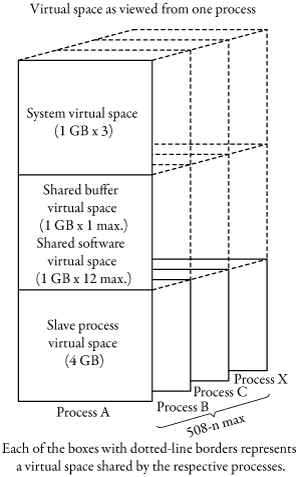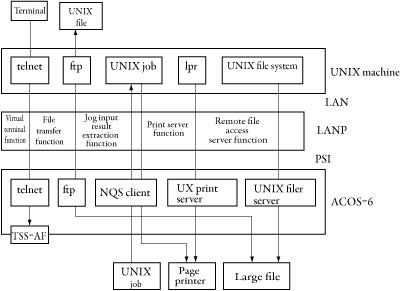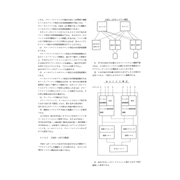NEC announced ACOS-6/MVX II (Multiple Virtual eXtended II) in November 1988, and started shipping it in March 1989.
ACOS-6/MVX II was an operating system for large to ultra-large machines that achieved enhanced functionality, expandability and reliability while maintaining upper compatibility with the operating systems ACOS-6 and ACOS-6/MVX for large machines, which were shipped earlier. It enabled establishment of a larger-scale, higher-performance relational database system and a more available hot-standby fault-tolerant system than ACOS-6/MVX. ACOS-6/MVX II was installed as an upper compatible successor OS to systems 830, 850, 930, 1000 and 2000, which operated with ACOS-6/MVX.
Features of the newly adopted architecture and of major functions included the following:
1. Features of the Architecture
(1) Expansion of the virtual space
The OS expanded the size of one virtual space from the previous 1 GB to 4 GB in response to growing program sizes. This resulted in a 2-TB virtual space per system, allowing large-scale arithmetic processing and high-speed database processing.
 Figure 1
Figure 12. Features of the Functions
(1) Integrated online database
The OS provided the high-performance relational database RIQS II with a larger capacity, higher processing performance and higher operability than RIQS (Relational Information Query System), which was supported by
ACOS-6/MVX, in addition to enhancement of the network type database ADBS (Advanced Data Base System), which was supported by
ACOS-6. Additionally, it provided TQF II, which had functions for online database search and report preparation. Use of the high-performance, high-reliability transaction processing system TDS-AF enabled a further advanced online database to be built on this platform.
(2) Programming languages and development environment
The OS realized a highly efficient application development environment by strengthening support for COBOL 85 and C language and supporting the highly productive language IDL II (Integrated Data oriented Language II), software development support system SOFPIA (Software Productivity Improvement Aid) and distributed development environment SOFPIA PWB (Personal Work Bench).
(3) Support for automated peripherals and faster peripherals
To meet the demand for faster communication, larger file sizes, higher speeds and automated operations in response to expansion of business operations, the OS achieved support for high-speed FNP (Front-end Network Processor) equipment, adoption of a cartridge library unit that did not require an operator, adoption of a large-capacity high-speed disk unit and support for high-speed printers.
(4) Support for network standardization
The OS enabled OSI applications on ACOS-6/MVX II to communicate with their destination OSI systems in response to the trend toward standardization of OSI (Open Systems Interconnection). OSIS, ATAM and NPS-AF supported layers 1 (physical layer) to 5 (session layer), and supported file transfer (FTAM) and message/mail transmission/reception (MOTIS/MHS) as layer 7 (application service).
(5) Support for UNIX(*) connection
To meet the need for business operation linkage with open servers, NEC provided functions such as TELNET, FTP and UNIX file server and NQS batch request via TCP/IP communication as an enhancement of network connectivity between ACOS-6/MVX II and a UNIX machine.
(*: UNIX was an operating system developed and licensed by AT&T of the United States.)





